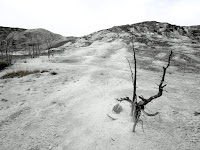Yellowstone National Park is home to 10,000 thermal features. Some
are found like hidden gems buried deep in the back country while
other thermal treasures are found along the Grand Loop Road – like
Midway Geyser Basin. Within this small basin lies the most
intensely-colored jewel of them all. It’s one of the Park’s most
iconic and photographed features …
This is a continuing series of blog posts on Yellowstone National
Park. I’ve already shared information about some of Yellowstone’s
geyser basins (a link about many of them follows this post). Today,
we are heading to the Midway Geyser Basin which is considered part of
the Lower Geyser Basin. We
will be walking the boardwalk trail in a clock-wise direction. This
easy 8/10’s of a mile loop trail is a popular spot. We call it a
“filler hike” because short walks are what we do when we have
small pockets of time between other activities.
Midway Geyser Basin & Firehole River
Midway is aptly named because it is located half-way between the
Upper and Lower Geyser Basins. It is on the west side of the Grand
Loop Road a
short distance north of the Old Faithful area.
NPS Map
Midway may be a small geyser basin but it has two of the largest
thermal features in Yellowstone – Excelsior Geyser Crater and Grand
Prismatic Spring. While it was named Midway Geyser Basin in 1878, it
was known by another popular name - “Hell’s Half Acre”.
Exhibit Map
In the 1880’s Excelsior Geyser had eruptions up to 300 feet high and 300 feet wide. Can you imagine how those early explorers felt when the ground
started shaking under their feet and they heard the rumbling noises
coming from the bowels of the earth? It’s no wonder someone thought all hell was breaking loose here.
It was named in 1881 by the Park’s Superintendent. “Excelsior”
is the Latin word for “higher”. Once it was the world’s
largest geyser. Today, Excelsior’s gaping crater (276’x328’)
emits billowing clouds of steam but shows little to no signs of
activity.
Excelsior Geyser Crater
We begin walking toward Grand
Prismatic Spring. Across the way, I see people silhouetted against
the steamy background with their shadows reflecting in the pools of
water.
Grand Prismatic Spring (250’x380’ and 125’ deep) is the largest
hot spring in Yellowstone and the third largest in the world (New
Zealand has the other two springs). The spring’s brilliant
colors were the inspiration for its name. It’s easy to see why
the iconic Grand Prismatic Spring is one of the Park’s most
photographed landscapes.
Grand Prismatic Spring
Close-Up of Run-Off - Grand Prismatic Spring
So, here’s the scoop on Grand Prismatic Spring. You can not see or
appreciate its size and beauty from ground level. To truly view its
grandeur, you need to take a hike. Begin at the Midway Geyser Basin
parking lot and follow the Fairy Falls trail. In less than a mile,
you will turn onto the recently established side trail up the
hillside to an observation area. We did this side trail up the
hillside during our hike to Fairy Falls in 2010. The above photo was
taken from that vantage point.
We continue walking around the boardwalk trail to Opal Pool. I can’t
find any information about this pool (size or how it got its name).
Maybe my next visit to Yellowstone I can ask a Park Ranger at a
Visitor Center. If I find any information, I will add it to this
post.
Opal Pool
The
last major thermal feature in the Midway Geyser Basin is Turquoise
Pool (100’x110’). The 1878 Hayden Expedition named this pool for
its gem-like, blue-colored water.
Turquoise Pool
No matter how many times I visit Yellowstone, I never get tired of
seeing its ever-changing scenery. I invite you to view my other blog
posts on Yellowstone National Park by clicking on the following
links:
Yellowstone: A Ton of Fun at the Canyon
Hiking Yellowstone: Fairy Falls & Imperial Geyser
Yellowstone Scenic Drive: Firehole Canyon
Hiking Yellowstone: Fairy Falls & Imperial Geyser
Yellowstone Scenic Drive: Firehole Canyon
Yellowstone: Mud Volcano - Stop and Smell the...Sulfur?
Hiking Yellowstone: NW Corner - More Space; Less Crowded
Hiking Yellowstone: NW Corner - More Space; Less Crowded
Planning a visit to Yellowstone? Food and lodging options are
available inside the park and in towns just outside the park (West
Yellowstone, Gardiner, and Cooke City/Silver Gate – all located in
Montana). I highly recommend making lodging reservations in advance.
Yellowstone is a popular destination and “No Vacancy” signs are
common especially during the peak summer months. Since opinions,
preferences, and budgets vary, I suggest checking a trusted travel
source for current reviews.
My best advice is this - don’t just drive through Yellowstone –
experience it!
The National Park Service has created a series of short videos titled
“Inside Yellowstone”. It’s a fast and fun way to learn about
the Park. Click on the following link to begin this Yellowstone
experience.
Family vacations created some of my favorite memories. To start
planning your memorable trip to Yellowstone, please click on the
following link:



















